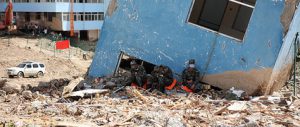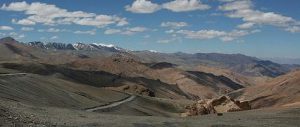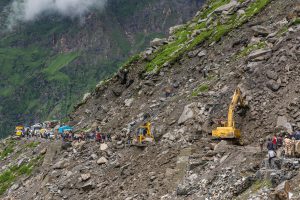The gravest hazards arise at the time of the landslides and later if landslide dams collapse, releasing sudden floods. The greatest historical floods on the upper Indus came from short-lived landslide dams in 1841 and 1858. Temporary losses arose when the lakes inundated settlements and severed communications, as again above Attabad in 2010, when 25,000 people were cut off from the outside world in the valleys above the lake.
Yet landslide-related hazards are not confined to these short-lived extremes. The aggradation phase can become increasingly hazardous. As sediment builds up in channels, the more frequent regional hazards – debris flows, rainstorm and glacier-melt floods – will change paths across fans and deltas, threatening arable land and even village sites. Rock avalanche material mobilised by heavy rains or flood scour can feed damaging debris flows, as happened at Gol in 1996. Fields were left buried in rubble, and boulders acted like battering rams destroying walls and homes.
Local communities do observe strategies to reduce or prevent harm from these more common mountain hazards through land use, watching places or weather conditions that are dangerous, or coming together to repair property after a damaging event. However, the landslides themselves are dangers of a different order.
The evidence outlined in this series raises singularly disturbing questions about what triggers them and the marked disparity between their prehistoric and historical numbers. Because nearly all 375-plus rock avalanches affecting the rivers descended across ice-free valleys, they post-date the last major glaciation (LMG), about 12,500 to 10,000 years ago. The 11 events with numerically-determined ages, and some 30 related to them through the sedimentation record, happened between 2,000 and 8,000 years ago. In geological, rather than human terms, the landslides are very young.
Meanwhile, surveys to date cover barely 25% of the basin. If these are at all representative, four times as many may yet be discovered over a mountainous area of about 100,000 square kilometres. The record of recent centuries offers no precedent for their numbers, or their magnitudes.
Immediate triggers of large landslides are usually earthquakes or weather extremes. Stormy weather has been associated with several cases, but larger Karakoram events seem too deep-seated. They were most likely co-seismic. The 1841 landslides were triggered by an earthquake, and instabilities leading to the 2010 event are traced to a 2002 earthquake. However, these and the 1858 event, though very destructive, are among the smaller rock avalanches; one reason their dams failed so quickly. Many prehistoric examples are one to three orders of magnitude larger, and seem to require equally powerful earthquakes.
Another puzzling fact, however, is that the Karakoram appears relatively “quiet” seismically. Modern records for the Skardu-Shigar basins show only minor, scattered seismic sources, although some 16 massive rock slope failures are known. Most are younger than about 8,000 years, and at least nine are between 4,000 and 2,000 years old. How, therefore, do we explain the larger landslides – and so many more occurring prior to historical records? Larger earthquakes seem required even than those that caused major disasters in surrounding areas, such as at Quetta in 1935 (magnitude 7.7) or Kashmir in 2005 (magnitude 7.6).
The landslides evidence seems increasingly to support the hypothesis of Peter Molnar, Roger Bilham and others about missing great Himalayan earthquakes. Mega-earthquakes (magnitude 8 or 9) are thought to follow a “seismic cycle” as it takes time to accumulate tectonic stress in an area and then release it during a large earthquake. But some areas of the Himalayas have not experienced such an earthquake for over 500 years. The northwest Himalaya, according to seismic and geodetic studies, seems overdue for a mega-earthquake – what Californians call “the Big One”.
If the larger landslides are indeed triggered by mega-earthquakes, it means that rare, seismo-tectonic events punctuate, reset and, ultimately, control the landscape agenda. The landslide-related features along the Indus streams support such a view. They develop on millennial time scales and, coincidentally, create conditions favourable to generations of human habitation.
More sobering, however, are the rare but cataclysmic hazards implied: events that combine great earthquakes with multiple large landslides, river valleys inundated above, and starved of sediment and water below, for centuries at least. And no capacity presently exists to predict, let alone prevent, events on such scales.
Certainly, more could and should be done to adopt and enforce higher levels of structural safety for buildings, which could at least save lives away from mega-earthquake epicentres and landslide run-out zones. Regional preparedness, if more effective than in recent earthquake disasters, could improve survival and recovery possibilities. For the moment, however, expanding towns and cities, along with large-scale infrastructure, notably big dams and highways, are increasing the concentrations of people and structures at risk.
Through most of history, land use in the Himalaya was organised around widely scattered villages and smallish centres. Today, such an approach is commonly treated as outmoded – a less efficient form of existence – and in many cases traditional risk-averting arrangements and environmental knowledge are being undermined or lost. On the other hand, the inhabitants may carry a deep historical understanding about collective security for living with a catastrophically generated land base. Their landslide stories may be more realistic than fatalistic in coming to terms with such an environment.
Finally, although the Karakoram has exceptional numbers, landslides and landslide-related developments clearly exist in other mountains. Examples are known, and the list grows rapidly, throughout High Asia, in the western cordilleras of the Americas, the European and New Zealand Alps and the Caucasus. In some of these, too, indications of rare mega-earthquakes are being investigated. The situation supports calls for a revised concept of the drivers of landform development in high mountains, and a rethinking of responses to the geo-hazards involved.
Kenneth Hewitt is professor emeritus in geography and environmental studies and research associate at the Cold Regions Research Centre at Wilfrid Laurier University in Ontario, Canada. This is an updated version of an earlier article, published in the American Scientist in 2010.
Homepage image by Wilson X



